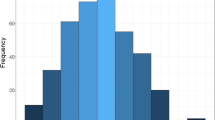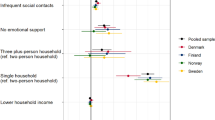Abstract
We examine the perception of social exclusion and quality of life and their interactions among a group of Turkish citizens. For this purpose we used the social exclusion scale developed by Jehoel-Gijsbers and Vrooman and the WHOQOL-BREF scale. The study group consists of 2,493 participants who are residents of a city in Turkey. Our study was based on self reporting and voluntary participation. We used SEM (Structural Equation Modeling) for the analysis. We observed significant paths among several dimensions of quality of life and social exclusion. We found that the material deprivation dimension of social exclusion has a direct and negative impact on the environment and social relationships domains of quality of life. The material deprivation dimension explains 36% of the variation in the environment and 16% of the variation in social relationship domains of quality of life. This finding indicates that the material deprivation and social participation play an important role in the perception of environmental and psychological life quality. Physical health, social relationships, and environmental domains of life quality are important in the social participation dimension of perceived social exclusion.

Similar content being viewed by others
References
Åsbring, P., & Narvanen, A.-L. (2002). Women’s experiences of stigma in relation to chronic fatigue syndrome and fibromyalgia. Qualitative Health Research, 12, 148–160.
Atkinson, T., Cantillon, B., Marlier, E., & Nolan, B. (2002). Social indicators. The EU and social inclusion. Oxford: Oxford University Press.
Biswas-Diener, R., & Diener, E. (2001). Making the best of a bad situation: Satisfaction in the slums of Calcutta. Social Indicators Research, 55, 329–352.
Burchardt, T. (2000). Social exclusion: concepts and evidence. In D. Gordon & P. Townsend (Eds.), Breadline Europe: The measurement of poverty (pp. 385–406). Bristol: The Policy Press.
Dickson, A., Knussen, C., & Flowers, P. (2007). Stigma and the delegtimation experience: An interpretative phenomenological analysis of people living with chronic fatigue syndrome. Psychology & Health, 22(7), 851–867.
Diener, E., & Diener, C. (1995). The wealth of nations revisited: Income and quality of life. Social Indicators Research, 36, 275–286.
Eser, E., Fidaner, H., Fidaner, C., Yalcin, S. E., Elbi, H., & Goker, E. (1999). WHOQOL-100 ve WHOQOL-BREF’in psikometrik özellikleri. 3 P (Psikiyatri, Psikoloji, Psikofarmakoloji) Dergisi, 7(supp. 2), 23–40. The psychometric properties of WHOQOL-100 and WHOQOL-BREF. 3P (Psychiatry, psychology, psychopharmacology) Journal, 7(supp. 2), 23–40.
Eurostat. (2010). Combating poverty and social exclusion. Luxembourg: Publications Office of the European Union.
Ferriss, A. L. (2006). A theory of social structure and the quality of life. Applied Research in Quality of Life, 1, 117–123.
Henriksson, C. (1995). Living with continuous muscle pain-patient perspectives: Part I. Encounters and consequences. Scandinavian Journal of Caring Science, 9, 67–76.
Jason, L., Taylor, R. R., Plioplys, S., Stepanek, Z., & Shlaes, J. (2002). Evaluating attributions for an illness based upon the name: Chronic fatigue syndrome, myalgic encephalomyelitis and Florence Nightingale disease. American Journal of Community Psychology, 30, 133–148.
Jehoel-Gijsbers, G., & Vrooman, C. (2007). Explaining social exclusion: A theoretical model tested in the Netherlands. The Hague: The Netherlands Institute for Social Research.
Kline, B. R. (2005). Principles and practice of structural equation modeling (2nd ed.). New York: The Guilford Press.
Kohler, M., Clarenbach, C. F., Böni, L., Brack, T., Russi, E. W., & Bloch, K. E. (2005). Quality of life, physical disability, and respiratory impairment in Duchenne muscular dystrophy. American Journal of Respiratory and Critical Care Medicine, 172, 1032–1036.
Phillips, D. (2006). Quality of life: concept, policy and practice. Routledge: Abingdon.
Schmitz, M. F., & Crystal, S. (2000). Social relations, coping, and psychological distress among persons with HIV/AIDS. Journal of Applied Social Psychology, 30, 665–685.
Schumacker, R. E., & Lomax, R. G. (2004). A beginner’s guide to structural equation modeling (2nd ed.). New Jersey: Lawrence Erlbaum Associates Publishers.
Sen, A. (2000). Social exclusion: Concept, application and scrutiny. Social Development Papers No: 1. Office of Environment and Social Development. Asian Development Bank.
Sirgy, J. (1998). Materialism and quality of life. Social Indicators Research, 43, 227–260.
Skevington, S. M. (2009). Conceptualising dimensions of quality of life in poverty. Journal of Community & Applied Social Psychology, 19, 33–50.
Tsakloglou, P., & Papadopoulos, F. (2002). Aggregate level and determining factors of social exclusion in twelve European countries. Journal of European Social Policy, 12(3), 211–225.
WHOQOL-Group. (1994). Development of the WHOQOL: Rationale and current status. International Journal of Mental Health, 23(3), 24–56.
WHOQOL-Group. (1995). The World Health Organisation Quality of Life Assessment (WHOQOL): Position paper from the World Health Organisation. Social Science and Medicine, 41(10), 1403–1409.
WHOQOL-Group. (1998). The World Health Organisation quality of life assessment. Social Science and Medicine, 46(12), 1569–1585.
Acknowledgments
The authors would like to thank Scribendi Inc. for editing the language of this article.
Author information
Authors and Affiliations
Corresponding author
Rights and permissions
About this article
Cite this article
Bayram, N., Bilgel, F. & Bilgel, N.G. Social Exclusion and Quality of Life: An Empirical Study from Turkey. Soc Indic Res 105, 109–120 (2012). https://doi.org/10.1007/s11205-010-9767-4
Accepted:
Published:
Issue Date:
DOI: https://doi.org/10.1007/s11205-010-9767-4




